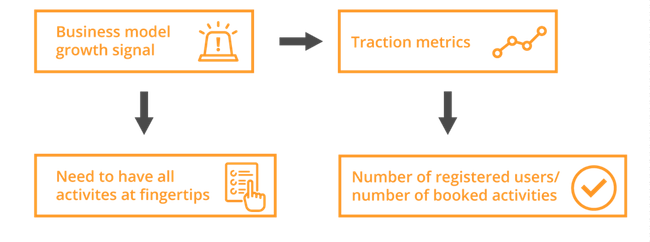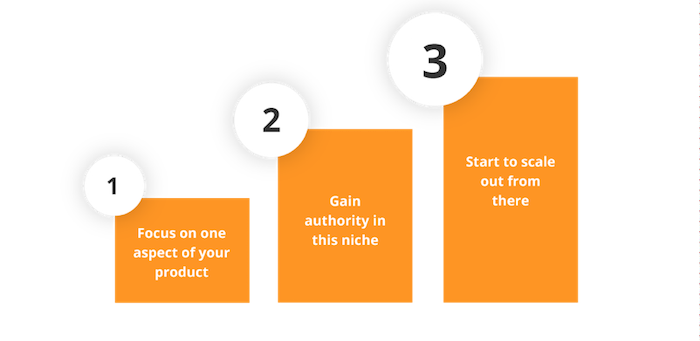

Updated December 18, 2024
Achieving success with a marketplace application requires your business to understand its target niche, customer preferences, and a smart scaling strategy.
An online marketplace is a multi-sided platform that matches product or service providers with potential customers.
In contrast to e-commerce websites that serve only a single business, marketplaces unite a variety of different businesses using a singular platform.
Looking for a Mobile App Development agency?
Compare our list of top Mobile App Development companies near you
If successful, a marketplace gains a decent client base and conversions and comes to a point when it needs to scale.
In this article, we provide effective tips on how to grow an online marketplace and achieve scale for your business.
Traction is the rate at which a business model captures monetizable value from its users.
In the world of marketplaces, traction is when you have achieved a “network effect,” which is when your platform attracts both service providers and people who need these services.
To create this effect and grow your business, you need to find the activities your users do now and that can bring you revenue in the future.
To determine these sorts of activities, study your client’s behavior, talk to your potential customers, and analyze the way they interact with your marketplace. For example, ask them to test your product and tell you what prevents them from making a purchase or what functionality will improve their user experience.
Tips for gaining traction for your marketplace startup include:
Once you achieve demand for your product, add new opportunities for your platform users.
For example, the owners of Rover, a marketplace that connects dog owners with dog sitters, discovered that their users ask sitters for other services, such as dog boarding, drop-in visits, grooming, or doggy daycare.
In response, they added these services and gained traction by creating not just a marketplace, but an entire community for pet lovers.

In business terms, the founders of this marketplace identified the business model growth signal – a need of additional services – which resulted in an increase in traction metrics, the number of daily users.
Another example of gaining traction is Yuggler, a marketplace for kids activities that allows parents to find and book different activities for their kids and families.
Although their product was unique and received positive reviews from friends, family, and potential customers, they failed to garner downloads on the App Store.
It turned out that the users wanted to have a larger number of activities to choose from, without spending 10-15 minutes on finding them.
In response, Yuggler added activities to its marketplace with photos and detailed descriptions. By enriching their platform with more content, they started to build a community.
In just one year, they reached 10,000 registered users.
In this case, the activity that drove traction was the desire of users to quickly find classes for kids. By focusing their efforts on this, Yuggler has significantly grown their business.

The business model growth signal for Yuggler was that parents wanted to quickly find activities for their kids. After they have added more content, the main traction metrics – the number of registered users and booked activities – increased.
After you have proved your value proposition, shift your focus to scaling.
There are various approaches to scaling which differ according to your market. These include:

The picture above describes the steps you should take to grow your marketplace.
Here are the main tips on how you can do this.
As your product grows, you get more users. As a result, you have to increase the control over your audience quality.Specifically, you need to guarantee to your customers that your platform is safe and reliable.
Here is how you can build the trust among them:
Create standards for your marketplace members and follow them as your platform grows. For example, Rover approves only 20% of applicants. If you carefully verify the requests you receive, you will build a reliable and proven community around your product. Here are the main things you need to check:
Ask both buyers and service/product providers to rate their experiences. This helps users identify which partners traditionally have positive experiences.
According to a UPS report, inconvenient returns policy deters 80% of shoppers. A good refund and return policy in the product marketplace gives your users more confidence in the legitimacy of your platform.
There are many of effective ways to promote your marketplace:
Word of mouth is an extremely effective technique for spreading knowledge about your product. It's not too costly, as mostly all it requires is your creativity. A great example of the effectiveness of word-of-mouth marketing is the food delivery marketplace Deliveroo. Every Friday, Deliveroo staff in Singapore put on kangaroo onesies to hand out different Deliveroo merchandise. This approach helped them create awareness for their brand.
Referral programs are widely used in popular online marketplaces such as Uber or Airbnb. Uber’s referrals program helped them grow and expand into 50+ countries in 3 years. Uber offers referral programs for drivers and riders. If the riders sign up for the first time, they get cash credits. If they refer a friend, both of them will get a referral reward.
Affiliate marketing is a way to get commission by promoting a product or service of another company on your website. For example, Preply, an online marketplace that connects tutors and students, uses an affiliate program in which anyone who places its link on their website can get 20% of the revenue on students and 2% of the revenue on teachers. One advantage of affiliate marketing is that you don’t pay for it until it provides results. If this strategy is suitable for your business, it is definitely worth trying.
Growing and maintaining a dedicated community is one of the best ways to scale your online marketplace.
Here is how you can do it:
To make your online marketplace more effective and valuable, include useful features. This will help you to improve your user experience and provide users with the necessary tools to interact with your platform.
To make your marketplace more advanced, you can add various third-party integrations. Here are some of the examples:
Custom quotes allow service providers set their own prices. You can also give your users an opportunity to get custom quotes instantly.
For example, ServiceWhale allows users to get a quote for home improvement online without the need for onsite visits from contractors.
Such an approach promotes transparency and promptness.
Custom admin panels for providers and buyers give your users more control over the buying and selling process. Admin panels also store key customer information, such as their activity, revenue, and orders, in one place.
The most important thing here is to listen to your users. User feedback helps you better provide your value proposition and grow your online marketplace.
Use these approaches to help you do it:


